


|
|
|
 |
| 09-10-2014, 10:33 AM | #1 |
|
New Member
2
Rep 8
Posts |
Logs from my 135i JB4 + DCI install...
I have a 09 135i with the N54 that I recently installed JB4 + DCI onto. I have been a long time lurker, but I never had much to post about since I have managed to keep the car stock. But, the warranty is getting close to the end and I couldn't resist any longer. In the past I have owned a couple 328i's, an E36 M3, a couple DSM's, an EVO VII, a WRX, an STi, an Audi A4 and S4... I have a good amount of experience tuning vehicles, especially turbo platforms.
Anyway, the JB4 install was painless and everything worked on the first try. The car pulls smoothly and feels like a factory tune. All good stuff. I am big on quantifying performance data from the car, so I took a bunch of logs. I wanted to compare the stock map to JB4 map 1 and 2 on pump fuel... with the stock intake and then again with the DCI. The first thing I noticed was that the time stamps produced by the JB4 logs do not seem to be reliable. After taking about five logs and comparing them, I realized the JB4 time stamps tend to be inconsistent and extremely optimistic, so there was no way of really determining if the car had become faster from just the JB4 logs. So, I used the Force app for Android which uses the accelerometer and GPS sensor to determine the cars acceleration, power and torque from here: https://play.google.com/store/apps/d...tronics.dynoid. Force gave me some good time stamps and power estimations and then I used the JB4 interface to log the vehicle sensors, mainly boost, timing advance and iat. Force will log the car via the OBDII sensor and also check and clear the engine codes, however, as soon as you touch the throttle with JB4 the OBDII sensor stops sending data. You can still clear check and clear codes, however. I just leave the OBDII bluetooth connector plugged into the car so I donít have to drag output my computer to read codesÖ kind of handy. I have an empty, flat, two mile stretch of road to do my logs. The car gets lots of cool down time at highway speeds between pulls so heat soak shouldn't be an issue. I had 91 octane in the car, it was about 80 degrees outside and the ambient air pressure was about 12psi (I live outside of Denver, 6000ft). Summary for those that donít want to read through the logs: The Fastest: Highest peak power and torque: Map 1 with a stock intake -> 314 ft/lb, 326 whp Highest average power and torque under curve: Map 2 with a stock intake -> 255 ft/lb, 192 whp Fastest 60-90mph: Map 2 with a stock intake -> 4.034 seconds The Slowest: Lowest peak power and torque: Stock map with the DCI -> 276 ft/lb, 281 whp Lowest average power and torque under curve: Stock map with DCI -> 230 ft/lb, 171 whp Slowest 60-09mph: Stock map with DCI -> 4.723 seconds The Gains: Peak power and Torque: 38 ft/lb, 45whp 60-90mph: 0.689 seconds Conclusions: JB4 has very decent gains for the money. The DCI did not improve performance, I am not sure why. They IATís didnít seem to increase, so perhaps something with the fueling. I think the IAT's are really hurting performance, so water injection or a FMIC is probably a better bet than an exhaust for now. JB4 maps 0-2 with the stock intake. The car makes a peak of about 280ft/lb at the wheels on the stock map and about 320ft/lb at the wheels on map 1 and 2. A gain of about 40ft/lb at the wheels. You can see map 2 making a good bit more torque up top than map 1. 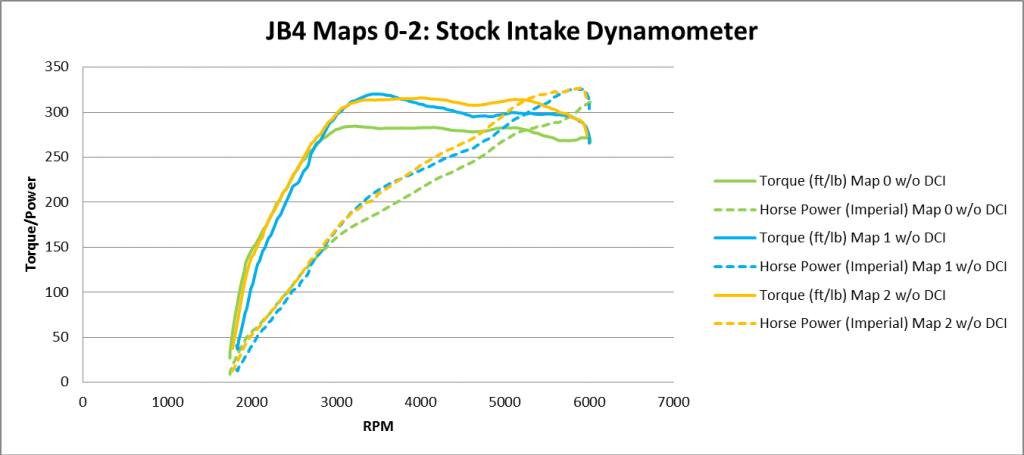 The car had a peak acceleration of 0.35g's on the stock map and 0.4g's on map 1 and 2. You can see map 2 pulling the hardest up top.  The car accelerated from 60-90mph about 0.7ths of a second faster going from the stock map to map 2, which is an impressive gain. Anything that can run 60-90mph at 6,000ft in less than 4 seconds on pump fuel is quite fast. 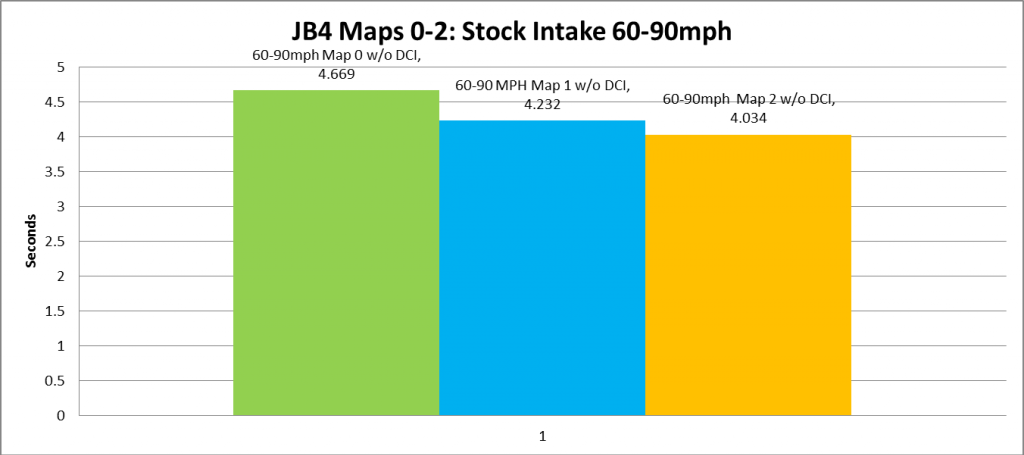 The corresponding boost log from JB4. You can see why map 2 makes more power up top and was faster from 60-90mph. 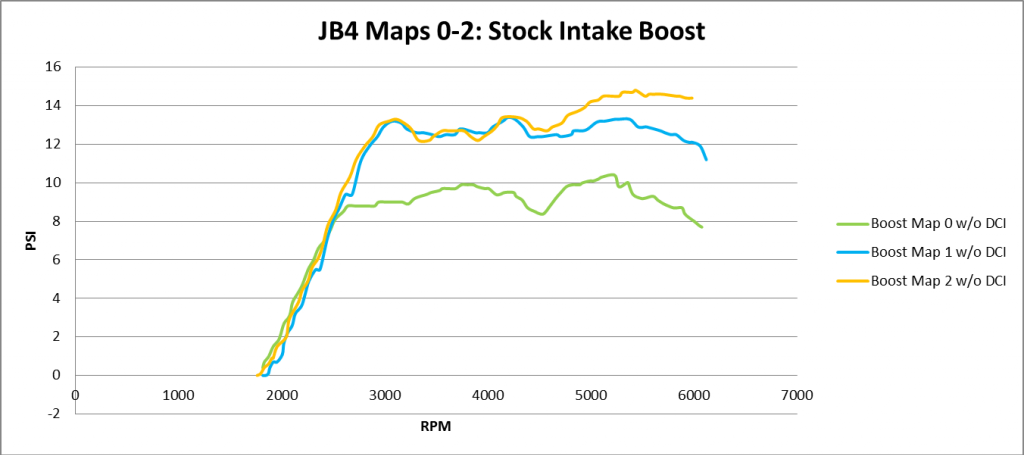 The timing advance log from JB4. The timing is poor, even on map 1. Time to consider water injection or a bigger intercooler. When it gets cooler, the timing will probably improve a great deal.  The iat log from JB4. Almost a 20 degree delta, not good. Again, time for water injection or an better intercooler. 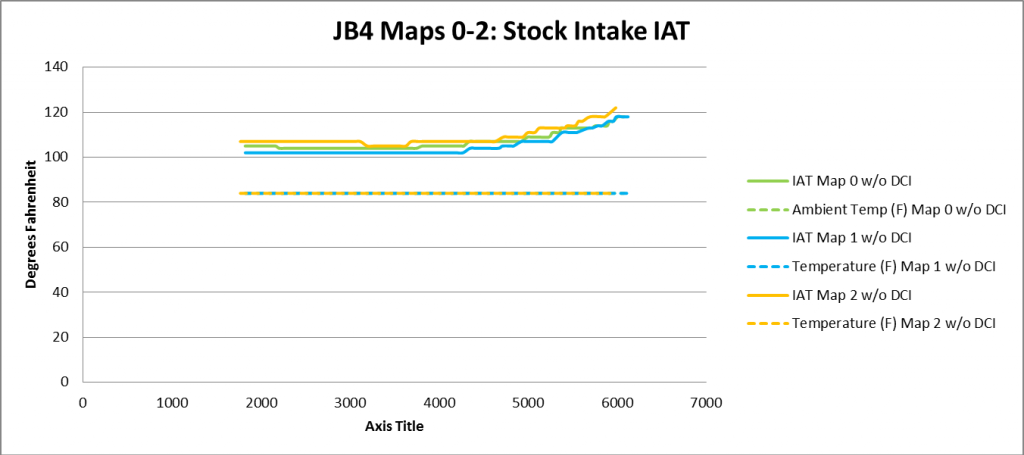 JB4 maps 0-2 with the DCI. The short of it is that the car was actually slightly (and I mean slightly) slower with the DCI vs the stock intake on all three maps. It took me about a half hour to install the DCI and the temperature outside went from 84 degrees to 86 degrees, but other than that, nothing changed. I can't say I see a performance gain. The torque and power... 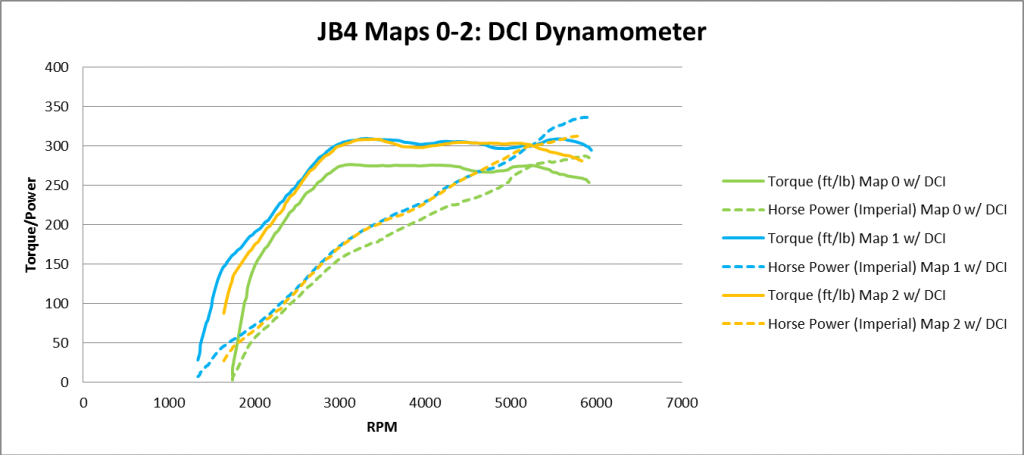 The acceleration... 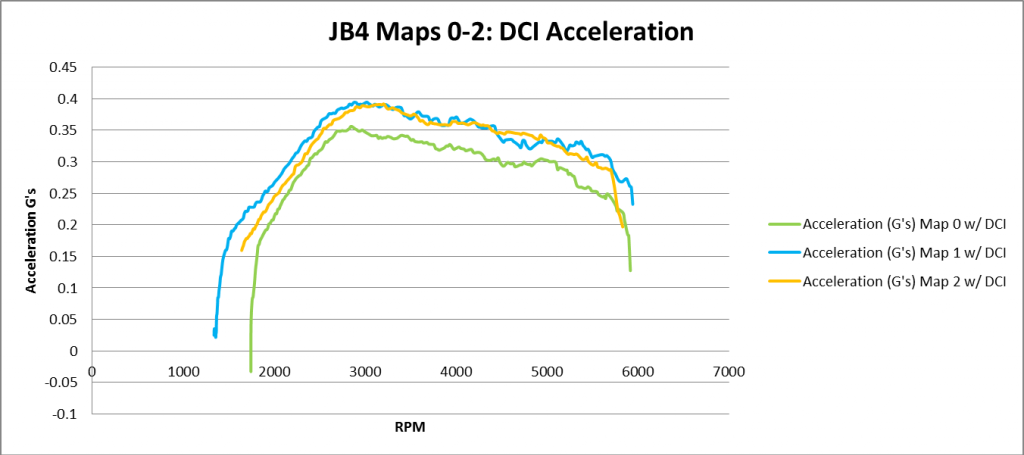 The 60-90mph times... 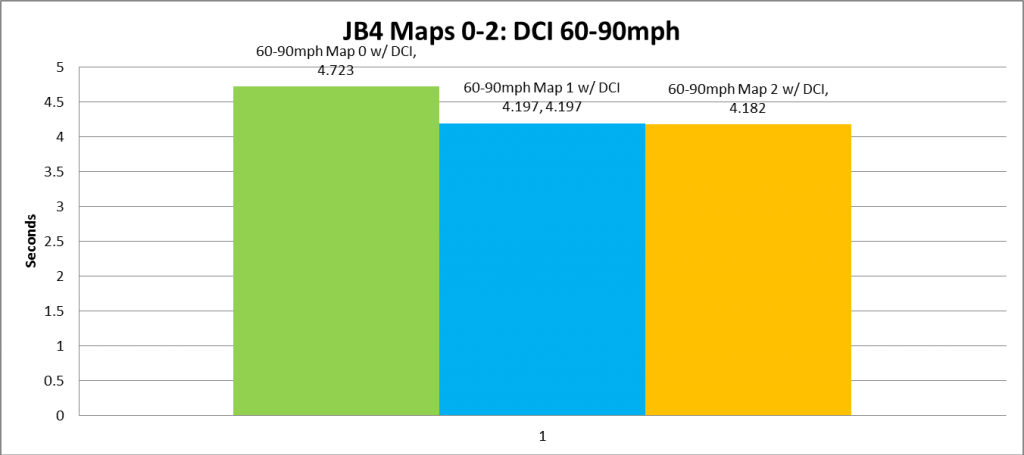 The boost... 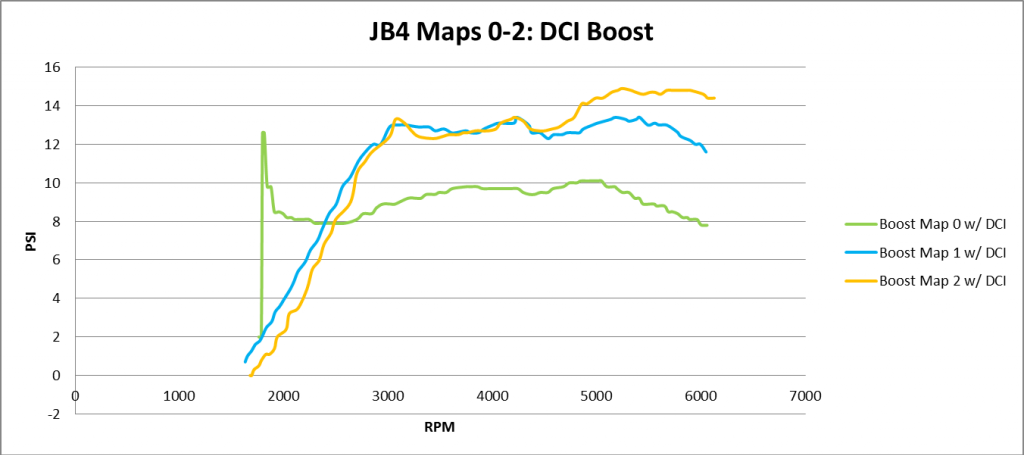 The ignition timing... 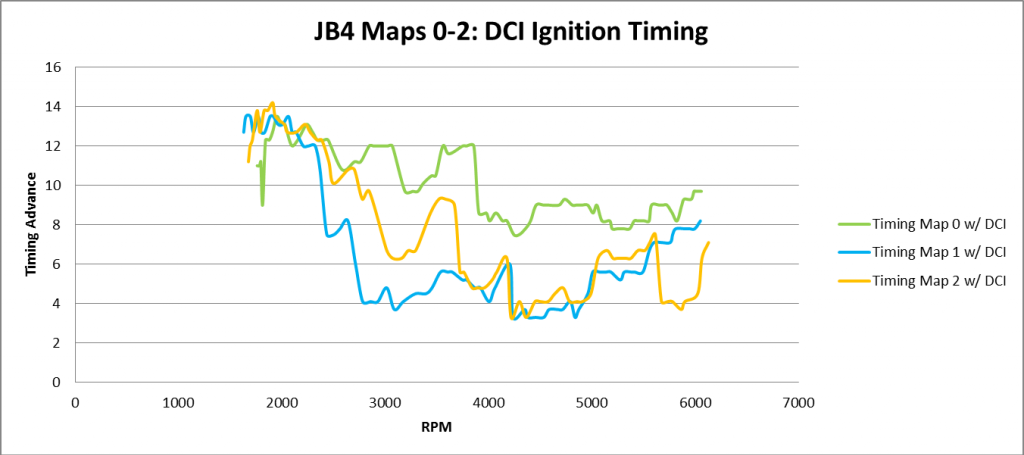 The iat... 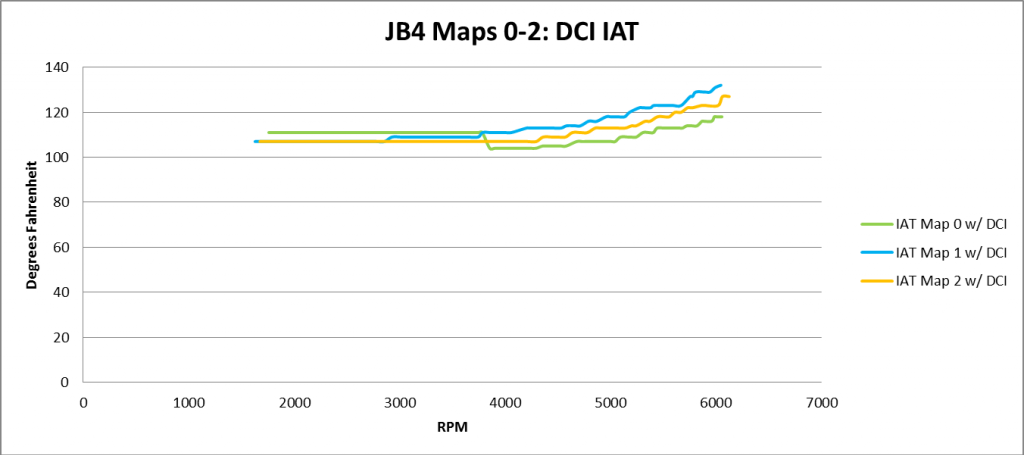 Individual Maps Stock Intake vs DCI I thought the DCI result was interesting, so I broke each map down into stock intake vs DCI comparisons if you are interested. The iats and timing stay about the same, so the DCI sucking hot air is probably not the issue. If I had to guess, my car just isn't making enough power for the stock intake to become a restriction. Stock Map: 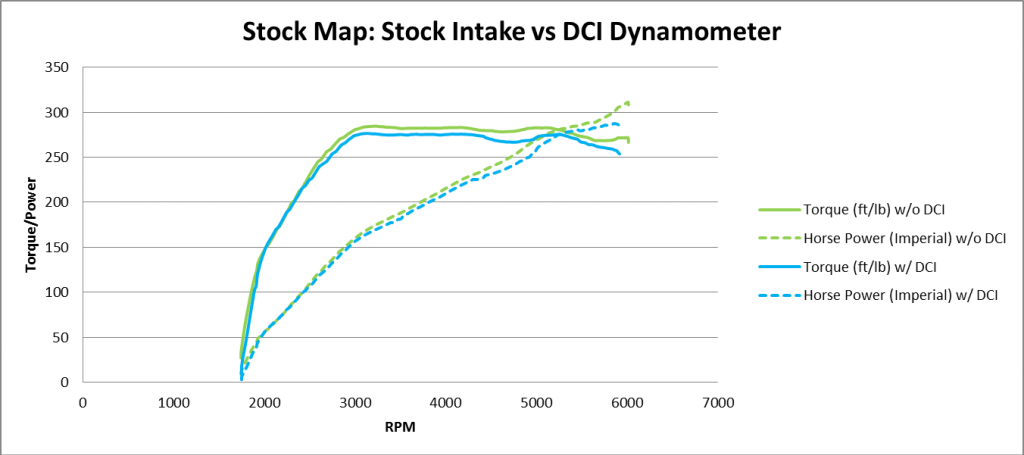 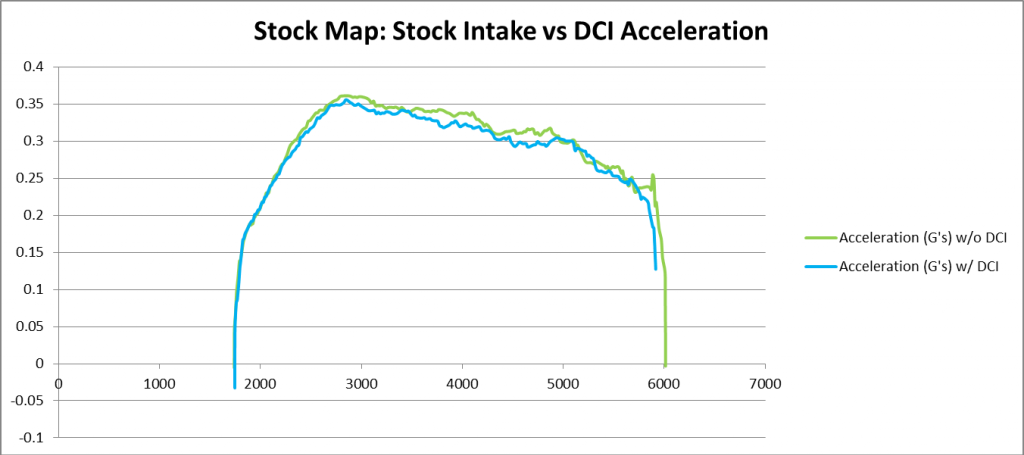 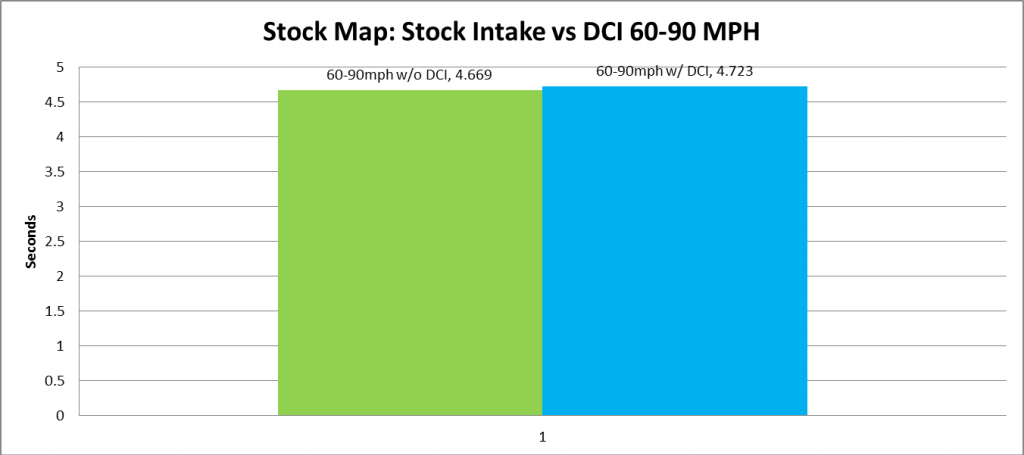  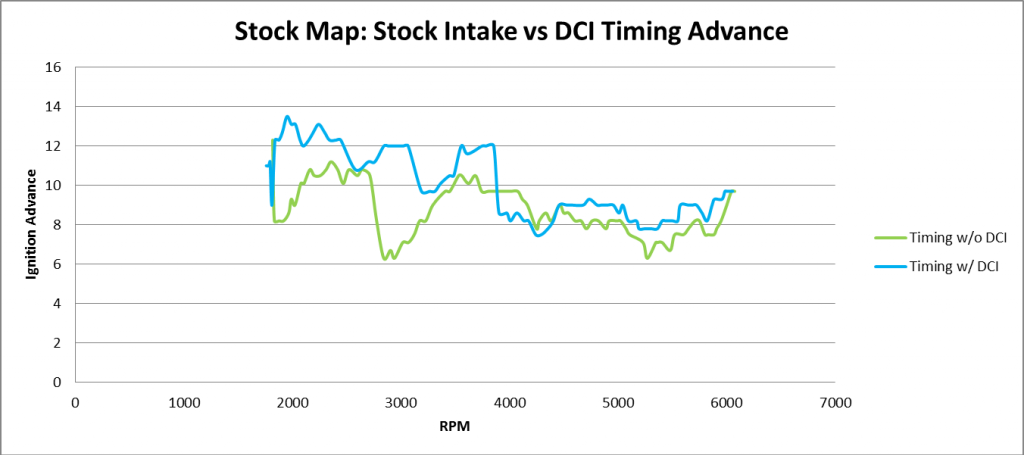 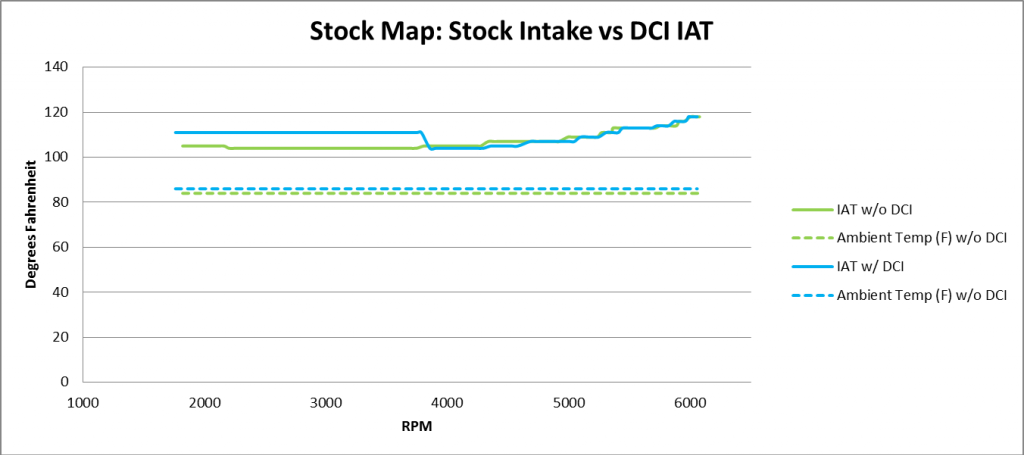 Map 1: 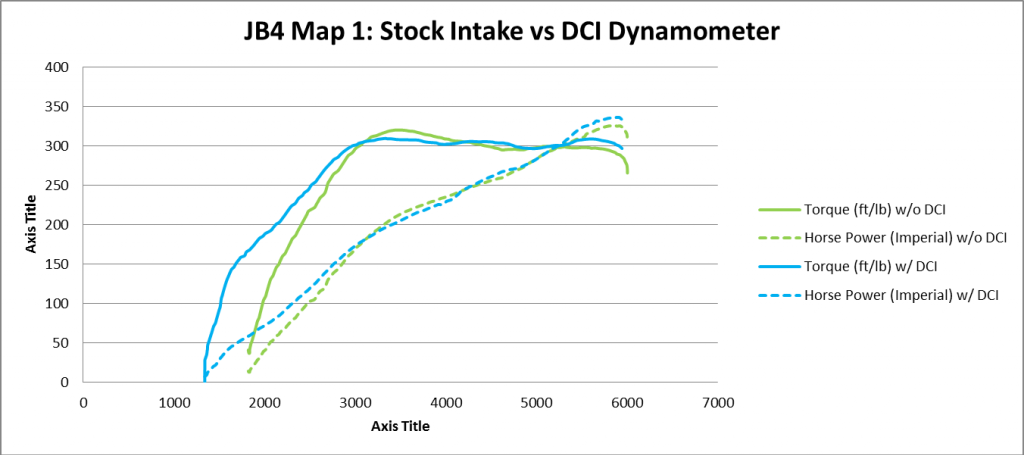 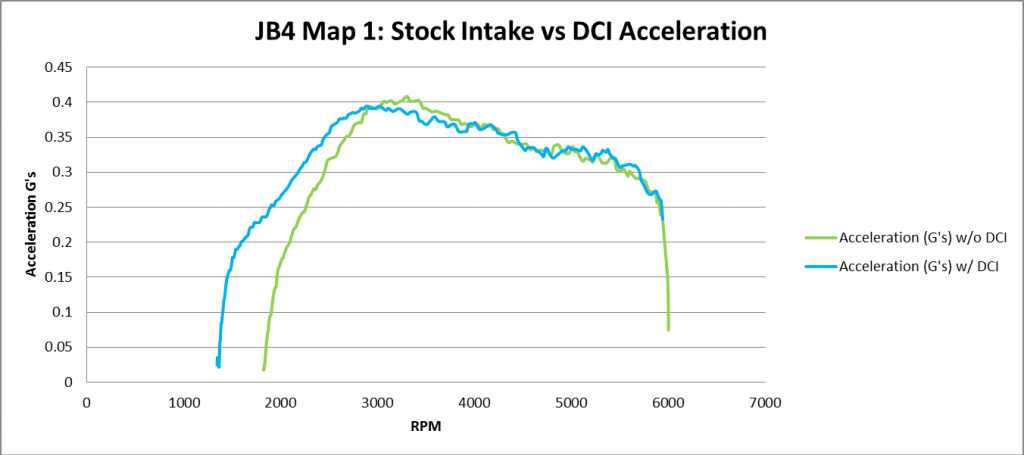 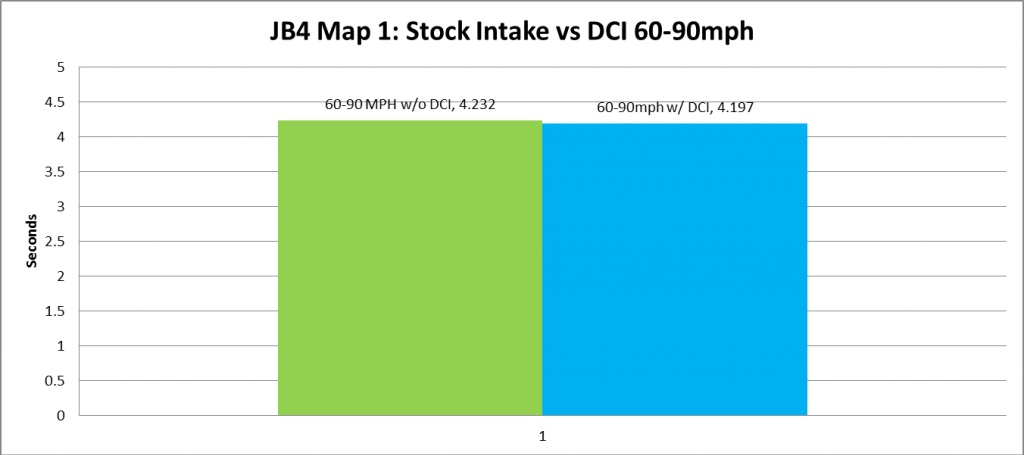 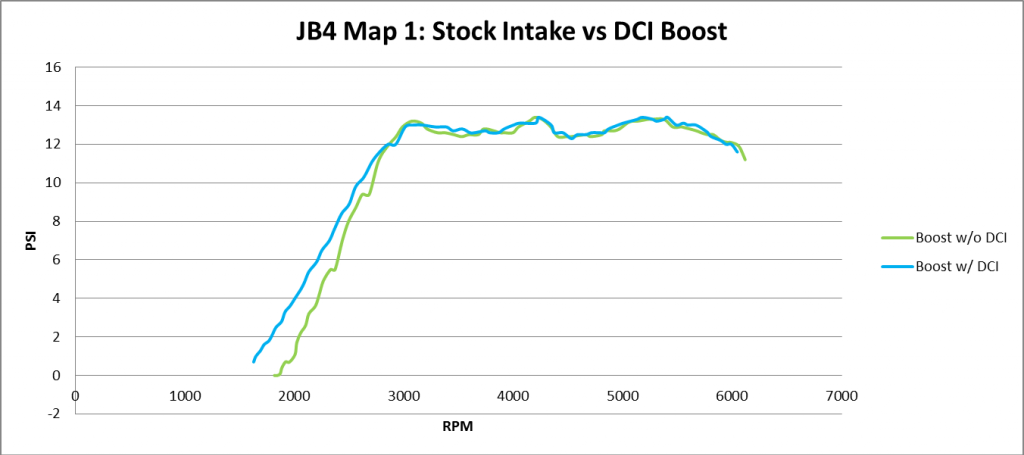 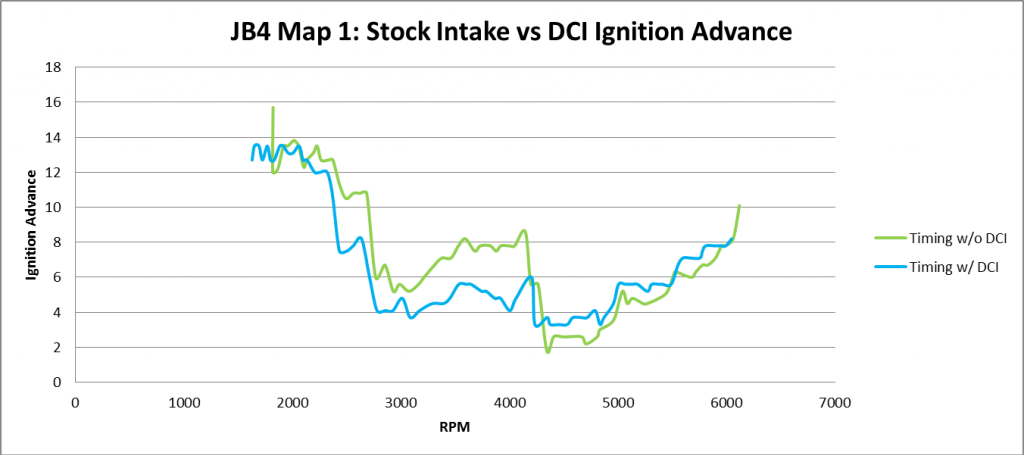  Map 2: 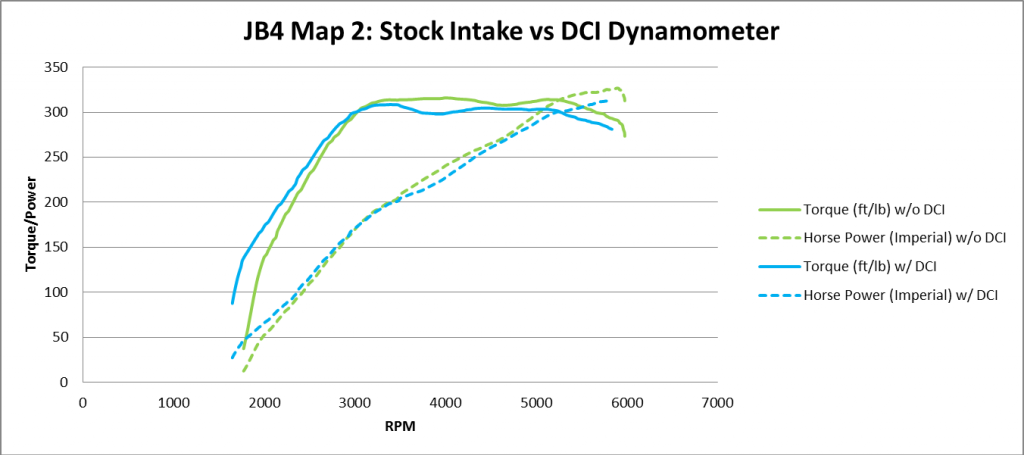 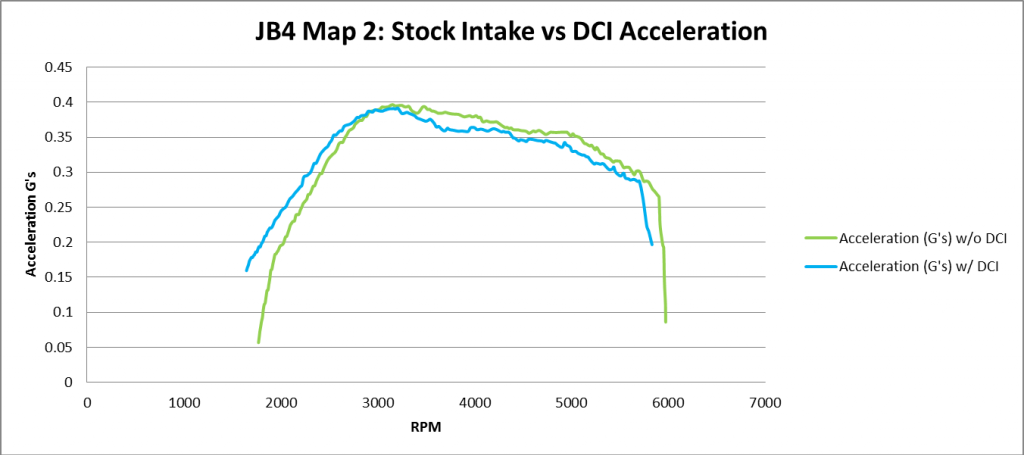 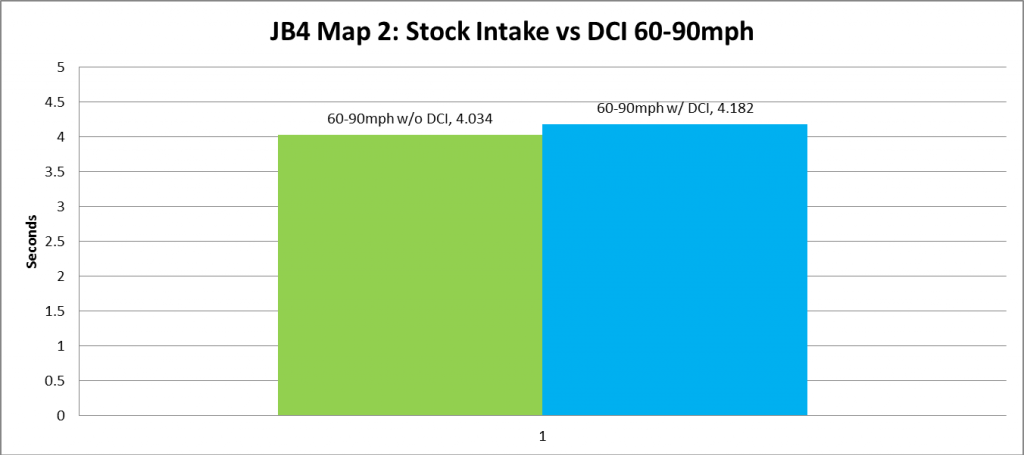 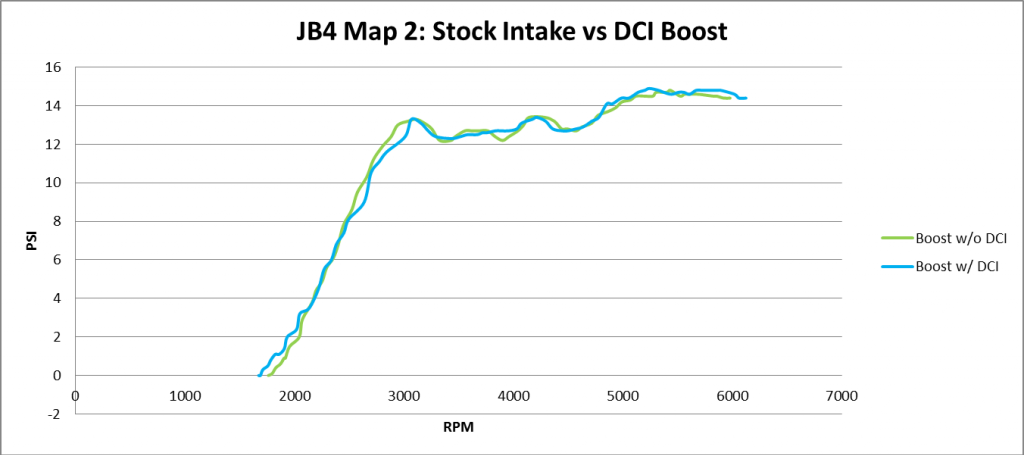 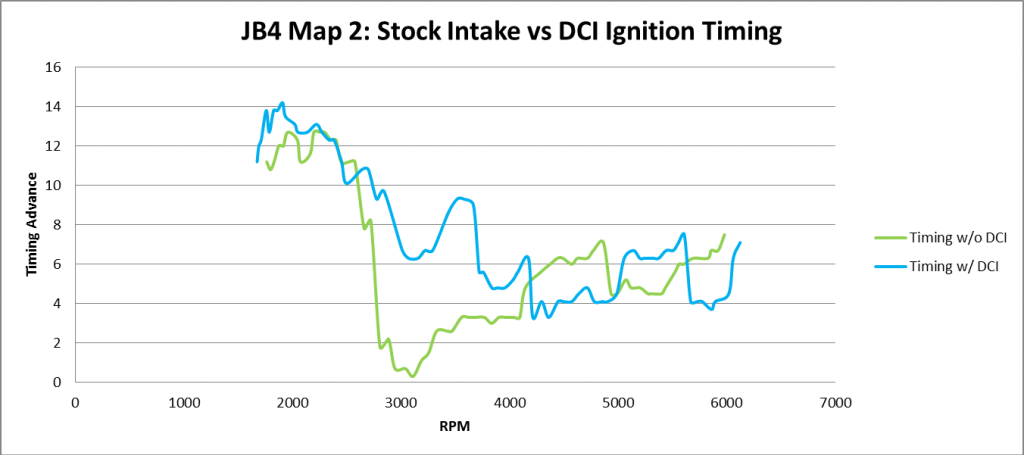  |
| 09-10-2014, 12:04 PM | #3 |
|
Private First Class
 55
Rep 182
Posts |
agreed great write up.
I wonder if the 91 octane, high elevation, and no dps is effecting your map 2 results? I plan to do some logs soon and I am at sea level, 93, with FMIC, dps, and running flash. I may try to use similar methods for comparison. Also, I had similar IAT, after a large FMIC the temps only rise ~ 5 deg or so. |
|
Appreciate
0
|
| 09-10-2014, 01:21 PM | #4 |
|
Joint Chiefs of Staff
 
24095
Rep 190,633
Posts |
Thank you for sharing
__________________
Check out our current sale by clicking on this link!
https://x-ph.com/sale/ Phone number 702-494-9435  |
|
Appreciate
0
|
| 09-10-2014, 05:16 PM | #5 | |
|
New Member
2
Rep 8
Posts |
Quote:
|
|
|
Appreciate
0
|
| 09-10-2014, 07:49 PM | #7 |
|
Private First Class
 55
Rep 182
Posts |
log results
I downloaded the dyno app you recommended, input all required parameters, and came up with completely different results. I have a BB flash, FMIC, DPs, 93 oct, sea level, and VERY hot outside. Temp outside was 99F during this pull. See attached pdf. I logged + virtual dyno.
max HP is 403, great torque, IATs actually dropped a little at first then rose ~ 3-4F. Note: map 1 shows 375. |
|
Appreciate
0
|
| 09-11-2014, 09:49 AM | #9 | |
|
New Member
2
Rep 8
Posts |
Quote:
|
|
|
Appreciate
0
|
| 09-11-2014, 11:45 AM | #10 |
|
Private First Class
 55
Rep 182
Posts |
Here are the excel files I used. I had to shift the dyno info as the rpm data was off. Its not as "clean" as your effort but its a quick comparison.
I wanted to share with you because how much the flash helped me. I had iffy logs with the jb4 before the flash, there is only so much a piggy back can do. Keep in mind these logs are on a car in 99+ Houston weather, peak of the day, without the best heat soak mitigation  . . Well its not letting me upload .xlsx or .csv files. Shoot me your email and I will send it to you. |
|
Appreciate
0
|
| 09-11-2014, 12:54 PM | #11 | |
|
Private First Class
 21
Rep 157
Posts |
Quote:
Boost guages are typically calibrated for 14.7 psi being zero on the gauge. So, if you are high altitude, they will read below zero when the car is off. |
|
|
Appreciate
0
|
| 09-11-2014, 01:05 PM | #12 |
|
Colonel
 
188
Rep 2,224
Posts |
Just curious why you aren't using map 5? Its superior to all maps IMO unless you have a VERY niche reason to be using another map such as 100% E85 or something rare.
|
|
Appreciate
0
|
| 09-11-2014, 01:09 PM | #13 |
|
Private First Class
 55
Rep 182
Posts |
I recommend anyone to consult with bms to get advise on which map to use. You should base it on logged parameters. For me map5 was to finicky and caused knock. Map 1 and 2 where good, the flash has been GREAT. I caution the use of any of the maps with out monitoring logs
|
|
Appreciate
0
|
| 09-11-2014, 04:39 PM | #14 | |
|
New Member
2
Rep 8
Posts |
Quote:
|
|
|
Appreciate
0
|
| 09-11-2014, 04:42 PM | #15 |
|
New Member
2
Rep 8
Posts |
Just because, for what I wanted to do with the DCI, it is hard to compare logs when the tune is changing. I haven't had a chance to play with map 5, but hopefully soon.
|
|
Appreciate
0
|
| 09-11-2014, 08:02 PM | #16 | |
|
Colonel
 
188
Rep 2,224
Posts |
Quote:
 Map 5 feels like a whole brand new car. I do urge you to drive nicely on map 5 for a half hour or so. Then start doing pulls and stuff. Switching right to map 5 and driving crazy can have odd results. |
|
|
Appreciate
0
|
| 09-12-2014, 07:33 AM | #17 | |
|
Private First Class
 21
Rep 157
Posts |
Quote:
It takes more work for a turbo to make the same boost in high altitude conditions since it has to spin faster to create the same amount of boost, but it will if it can. You run into power loss issues when you're already running a turbo close to its limits. In other words, the difference between 17 psi and 13 psi is still just 4 psi.  Edit: Also, you know MAP sensor means manifold absolute pressure sensor right? http://en.wikipedia.org/wiki/MAP_sensor Edit2: Make sure to read this section http://en.wikipedia.org/wiki/MAP_sen...ors_and_gauges Last edited by Stvee; 09-12-2014 at 09:17 AM.. |
|
|
Appreciate
0
|
| 09-12-2014, 12:47 PM | #18 | |
|
New Member
2
Rep 8
Posts |
Quote:
Let's assume we have a car that makes 10psi of boost relative to atmospheric pressure. At sea level you have 14.7psi of atmospheric pressure plus 10psi of relative boost pressure. 14.7psi + 10psi = 24.7psi of absolute pressure (relative to a vacuum). In Denver you would have 12psi of atmospheric pressure plus 10psi of relative boost pressure. 12psi + 10psi = 22psi of absolute pressure (relative to a vacuum). The car at sea level has 24.7psi-22psi = 2.7psi more absolute pressure than the car in Denver. It is clear that, assuming the same relative boost pressures, a car at altitude suffers a performance loss because of thinner air... just like a naturally aspirated car. You could compensate for the thinner air but increasing the boost as you claim, but the car at the higher altitude would need to increase the relative boost pressure by the difference in absolute pressure. When you say that the difference between the 13psi and 17psi is 4 psi, that is correct when you refer to pressure relative to the same atmospheric/absolute pressure. However, when there is a difference in atmospheric/absolute pressures, the difference between the two absolute pressures needs to be added to the relative pressure of vehicle with the lower absolute pressure to compare the total amount of air pressure entering the engines (which is what we are concerned with here). Both vehicles will have 13psi and 17psi, respectively, entering the engine relative to the atmospheric pressure, but the vehicle at sea level will have another 2.7 psi of atmospheric pressure entering the engine. If you put 17psi of pressure in a bottle at sea level, took the bottle to Denver and measured the pressure of the bottle again, you would see about 19.7psi. When we compare the absolute air pressure entering an engine at sea level and an engine in Denver, we need to add 2.7psi to the relative boost pressure of car at sea level to account for the difference in atmospheric pressure. So, my car in Denver has 13psi of boost + 12psi of atmosphere... 13psi+12psi = 25psi. The car at sea level has 17psi of boost + 14.7psi of atmosphere = 31.7psi. That is a difference of 6.7psi of absolute pressure entering the engine, a huge difference! You can't just turn up the boost to make up for the power on the car in Denver, either. If you work out the pressure ratios, you will see that both of them are about 2.3, despite the turbo at sea level making considerably more boost. The turbos were almost certainly tuned to work within a safe pressure ratio, which on the TD03 is quite small. I doubt the factory tune is increasing boost at altitude because doing so would dramatically increase the pressure ratio. If you look at the TD03 compressor map, you will see that a 2.3 pressure ratio is WAY out of the efficiency range, and that is only at 13 psi. Even 10psi in Denver is out of the efficiency range and that doesn't even make up for the difference in atmospheric pressure compared to sea level. A boost gauge that doesn't measure relative pressure is not a boost gauge, it is a absolute pressure sensor/altimeter. All boost gauges should measure relative pressure. |
|
|
Appreciate
0
|
| 09-12-2014, 01:08 PM | #19 | |
|
Private First Class
 21
Rep 157
Posts |
Quote:
It wouldn't make any sense to base the target psi off a relative pressure because it would constantly be changing at different altitudes. If you set it to an absolute pressure, you know how much air is going into the engine at a specific PSI. If it was relative, this would always be changing. Turbocharged cars not losing much power at altitude is one of things they're known for. This is because the target boost is an absolute pressure. Lower density air just means the turbo has to spin faster to make the same pressure as it would at a lower altitude. You kept saying this is an increase in boost, but its not. The turbo is just spinning faster to make the same pressure. You do lose a little power because you're getting close to (or out of) the compressors efficiency range and the air coming off the turbo gets hotter. As the WIKI article stated, boost gauges read absolute pressure minus 14.7 PSI. You can get some that can be re-calibrated, but like I said a normal mechanical gauge will read negative in high altitudes with the car off. Last edited by Stvee; 09-12-2014 at 01:24 PM.. |
|
|
Appreciate
0
|
Post Reply |
| Bookmarks |
|
|